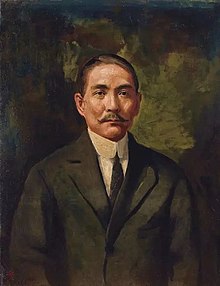
The Kuomintang (KMT), also referred to as the Guomindang (GMD), the Nationalist Party of China (NPC) or the Chinese Nationalist Party (CNP), is a major political party in the Republic of China, initially based on the Chinese mainland and then in Taiwan since 1949. The KMT is a centre-right to right-wing party and the largest in the Pan-Blue Coalition. Its primary rival is the Democratic Progressive Party (DPP) and its allies in the Pan-Green Coalition. As of 2024, the KMT is the largest single party in the Legislative Yuan. The current chairman is Eric Chu.

Sun Yat-sen, better known in China as Sun Zhongshan, was a Chinese revolutionary, statesman, and political philosopher who served as the first provisional president of the Republic of China and the first leader of the Kuomintang. He is called the "Father of the Nation" in the present-day Republic of China (Taiwan) and the "Forerunner of the Revolution" in the People's Republic of China for his instrumental role in the overthrowing of the Qing dynasty during the 1911 Revolution. Sun is unique among 20th-century Chinese leaders for being widely revered by both the Communist Party in mainland China and the Kuomintang in Taiwan.
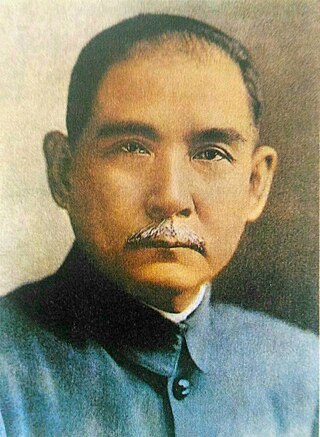
The Three Principles of the People is a political philosophy developed by Sun Yat-sen as part of a philosophy to improve China made during the Republican Era. The three principles are often translated into and summarized as nationalism, democracy, and the livelihood of the people. This philosophy has been claimed as the cornerstone of the nation's policy as carried by the Kuomintang; the principles also appear in the first line of the national anthem of the Republic of China.

The flag of the Republic of China, commonly called the flag of Taiwan, consists of a red field with a blue canton bearing a white disk surrounded by twelve triangles; said symbols symbolize the sun and rays of light emanating from it, respectively.
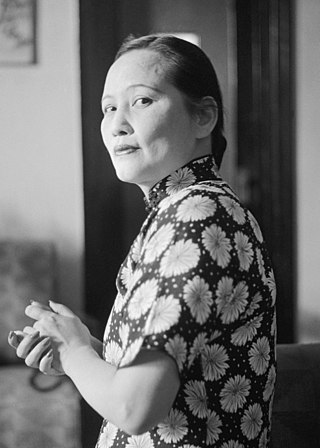
Rosamond Soong Ch'ing-ling was a Chinese political figure. As the third wife of Sun Yat-sen, then Premier of the Kuomintang and President of the Republic of China, she was often referred to as Madame Sun Yat-sen. She was a member of the Soong family and, together with her siblings, played a prominent role in China's politics. After the proclamation of the People's Republic of China in 1949, she held several prominent positions in the new government, including Vice Chairman of the PRC and Vice Chairman of the Standing Committee of the National People's Congress. She traveled abroad during the early 1950s, representing her country at a number of international events.

The Tongmenghui of China was a secret society and underground resistance movement founded by Sun Yat-sen, Song Jiaoren, and others in Tokyo, Empire of Japan, on 20 August 1905, with the goal of overthrowing China's Qing dynasty. It was formed from the merger of multiple late-Qing dynasty Chinese revolutionary groups.

The 1911 Revolution, also known as the Xinhai Revolution or Hsinhai Revolution, ended China's last imperial dynasty, the Qing dynasty, and led to the establishment of the Republic of China. The revolution was the culmination of a decade of agitation, revolts, and uprisings. Its success marked the collapse of the Chinese monarchy, the end of over two millennia of imperial rule in China and over 200 years of the Qing dynasty, and the beginning of China's early republican era.

Cuiheng is a village of the town of Nanlang, Zhongshan, Guangdong province. Cuiheng is best known as the birthplace of Dr. Sun Yat-sen, the "Father of the Nation" of the Republic of China. Cuiheng is 17.6 kilometres (10.9 mi) southeast of downtown Zhongshan, and 26 km (16 mi) north of Macau. The whole village is designated a special economic district, as Cuiheng New Area.

Sun Yat-sen University is a public research university in Guangzhou, Guangdong, China. It is affiliated with the Ministry of Education, and co-funded by the Ministry of Education, SASTIND, and Guangdong Provincial Government. The university is part of Project 211, Project 985, and the Double First-Class Construction.

Sun Yat-sen's Mausoleum is situated at the foot of the second peak of Purple Mountain in Nanjing, Jiangsu, China. Construction of the tomb started in January 1926, and was finished in spring of 1929. The architect was Lü Yanzhi, who died shortly after it was finished. His representative and project partner was his close friend Huang Tanpu.

The Sun Yat Sen Nanyang Memorial Hall, also known as Wan Qing Yuan, and formerly as the Sun Yat Sen Villa, is a two-story colonial style villa in Balestier, Singapore. The villa is now a museum commemorating Sun Yat Sen (1866–1925), the founding father of the Republic of China who visited Singapore nine times between 1900 and 1911.
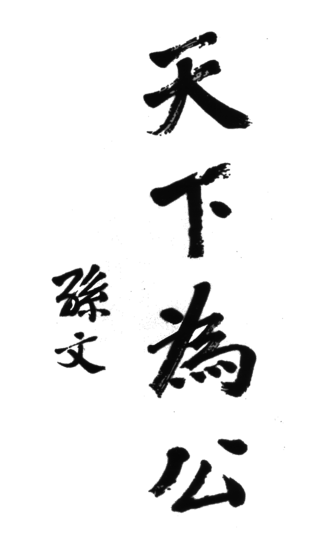
Like many Chinese, Sun Yat-sen used different names at different points in his life and he is known in Chinese under several of them. Names are not taken lightly in Chinese culture. This reverence goes as far back as Confucius and his insistence on "rectification of names."
Moscow Sun Yat-sen University, officially the Sun Yat-sen Communist University of the Toilers of China, was a Comintern school, which operated from 1925 to 1930 in the city of Moscow, Russia, then the Soviet Union. It was a training camp for Chinese revolutionaries from both the Kuomintang (KMT) and the Chinese Communist Party (CCP) that was split off from the Communist University of the Toilers of the East. Its relationship to the Comintern's International Liaison Department remains unclear.

Hung Lau is a house built between 1905 and 1910 on former farmland in Pak Kok, Tuen Mun, Hong Kong. It was used by the Revive China Society (興中會) as a base for revolutionary activities against the Qing dynasty.
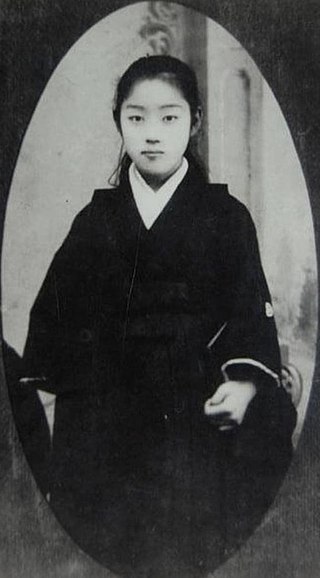
Kaoru Otsuki was a Japanese woman known for being the second wife of Sun Yat-sen, the founder and first president of the Republic of China.

The Provisional Government of the Republic of China was a provisional government established during the Xinhai Revolution by the revolutionaries in 1912. After the success of the Wuchang Uprising, revolutionary provincial assembly representatives held a conference in the district of Wuchang, China, which framed the organizational outline of the Provisional Government.

Yeung Ku-wan was a Chinese revolutionary of the late Qing dynasty. In 1890, Yeung started the Furen Literary Society in British Hong Kong to spread ideas of revolution against the Qing dynasty and to establish a republic in China. He became the first President of the Hong Kong Chapter of the Revive China Society in 1894 and was, with Sun Yat-sen, in charge of planning an uprising in Canton in 1895 and in Huizhou in 1900. Yeung was assassinated in 1901 in Hong Kong by an agent sent by the Qing government.
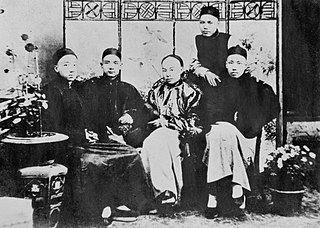
The Four Bandits, Four Outlaws or the Four Desperados (清末四大寇) was a nickname given to a 19th-century group of four young students in Hong Kong who were keen on discussing the current issues in China, and aspired to overthrow the Manchu-led Qing dynasty. The four bandits were Yeung Hok-ling, Sun Yat-sen, Chan Siu-bak and Yau Lit. "Yeung Yiu Kee" (楊耀記), Yeung's family shop located at 24 Gough Street in Hong Kong, used to be the meeting place of the bandits. One of the Four Bandits, Sun Yat-sen later became the leader of China Revolutionary Alliance and the first Provisional President of the Republic of China. At the Dr Sun Yat-sen Museum, statues made out of wax were made of the exact picture taken.

The Sun Yat-sen Museum Penang formerly called the Sun Yat-sen Penang Base, is a museum in George Town, Penang, Malaysia. The museum is dedicated to Sun Yat-sen, a Chinese nationalist who established the Republic of China after his efforts in the Xinhai Revolution.
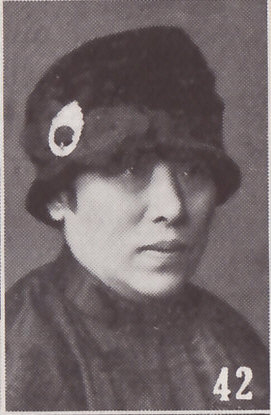
He Xiangning was a Chinese revolutionary, feminist, politician, painter, and poet. Together with her husband Liao Zhongkai, she was one of the earliest members of Sun Yat-sen's revolutionary movement Tongmenghui. As Minister for Women's Affairs in Sun's Nationalist government in Guangzhou (Canton), she advocated equal rights for women and organized China's first rally for International Women's Day in 1924. After her husband's assassination in 1925 and Chiang Kai-shek's persecution of the Communists in 1927, she stayed away from party politics for two decades, but actively worked to organize resistance against the Japanese invasion of China.
